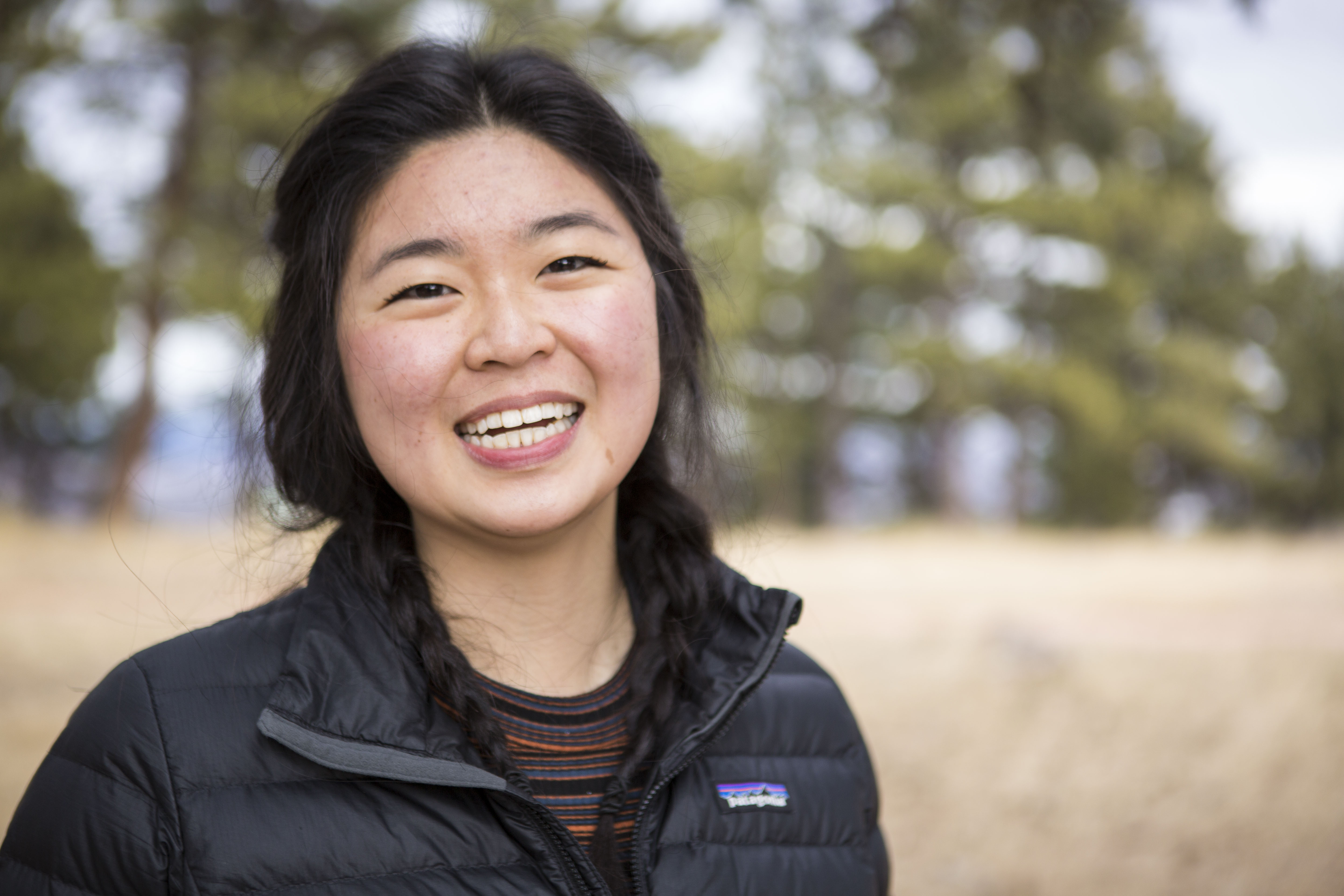It was a snowy, bitter-cold June day in the Rocky Mountains of Colorado when 20-year-old Amy Chen shook hands with death.
“It’s just a nightmare—just a nightmare. Go back to bed,” she kept telling herself. But she soon realized she wasn’t dreaming. Her battered body was pinned against the rocks on the side of a knife ridge, and there wasn’t a soul in sight who could save her.
Dangerous Attraction

The last photo Amy Chen took before her fall.
In the summer of 2015, Chen was invited by her friends to bag her first set of fourteeners. In just three days, she added six of Colorado’s “easy” peaks to her collection. It wasn’t so much her friends persuading her to climb them as much as what people around her were doing.
“Everyone’s doing them. You get on social media, and the sorority girls are doing them and your 45-year-old aunts and uncles are doing them. It’s like, this can be easy,” Chen said.
While it’s true that even the most ill-equipped hiker can reach the summit of many of Colorado’s staggering peaks, experts warn hikers of the deadly repercussions their mistakes could have.
“It is a wonder we don’t have several calls a day,” said Charles Pitman, a mission coordinator with the Summit County Rescue Group, “All you have to do is stand in the parking lot and see how people are equipped. And when they start, it really is mind-numbing—sandals, a bottle of water, shorts and a cotton t-shirt, no pack, no rain gear, no headlamp, little food, no emergency heat source and rain clouds on the horizon.”
Most fourteeners in Colorado are peaks that hikers of most skill levels can ascend. About two-thirds of them are rated Class Two or easier, meaning hands-free hiking. This is alluring to people that live east of the Rockies because it’s a low-risk thrill that they don’t get to experience every day.
So for many, hiking fourteeners in Colorado can be considered a passage into the state. Ninety-six mountains in the United States rise 14,000 feet above sea level. All of them lie west of the Mississippi river, and of those 96, Colorado has claim to 54.
It’s not just the inexperienced who find these mountains attractive. Many “peak baggers,” those who attempt to summit prominent peaks, see Colorado’s fourteeners as a challenge to accomplish.
Gerry Roach, author of Colorado’s Fourteeners: From Hikes to Climbs, has climbed more than 2,000 mountains in Colorado, including all of the state’s fourteeners. He said 54 peaks is a nice number—one that mortals can finish. Climbers and hikers have many options to choose from, and that’s why they come back year after year.
“Imagine if Colorado had 1,054 fourteeners! Only a handful of crazies would complete that list. Imagine if Colorado only had six fourteeners. People would start to look elsewhere,” said Roach.
Most people plan a fourteener trip in Colorado for late July or early August to allow for the snow to melt and the weather to warm up. Normally, Chen would have done the same with her trip to Mount Harvard, the third-highest summit of the Rocky Mountains in North America. But her ambitious goal to climb 21 of Colorado’s fourteeners by her 21st birthday in June stood in the way of rational decision.
The Fall
It was just after 3 a.m. on June 10, 2017, when Chen put on her hiking shoes and began the seven-mile hike toward the summit of Harvard—alone. Following the footprints in the snow, she wondered why she was the only person hiking in what is commonly a hotbed for late spring hikers.
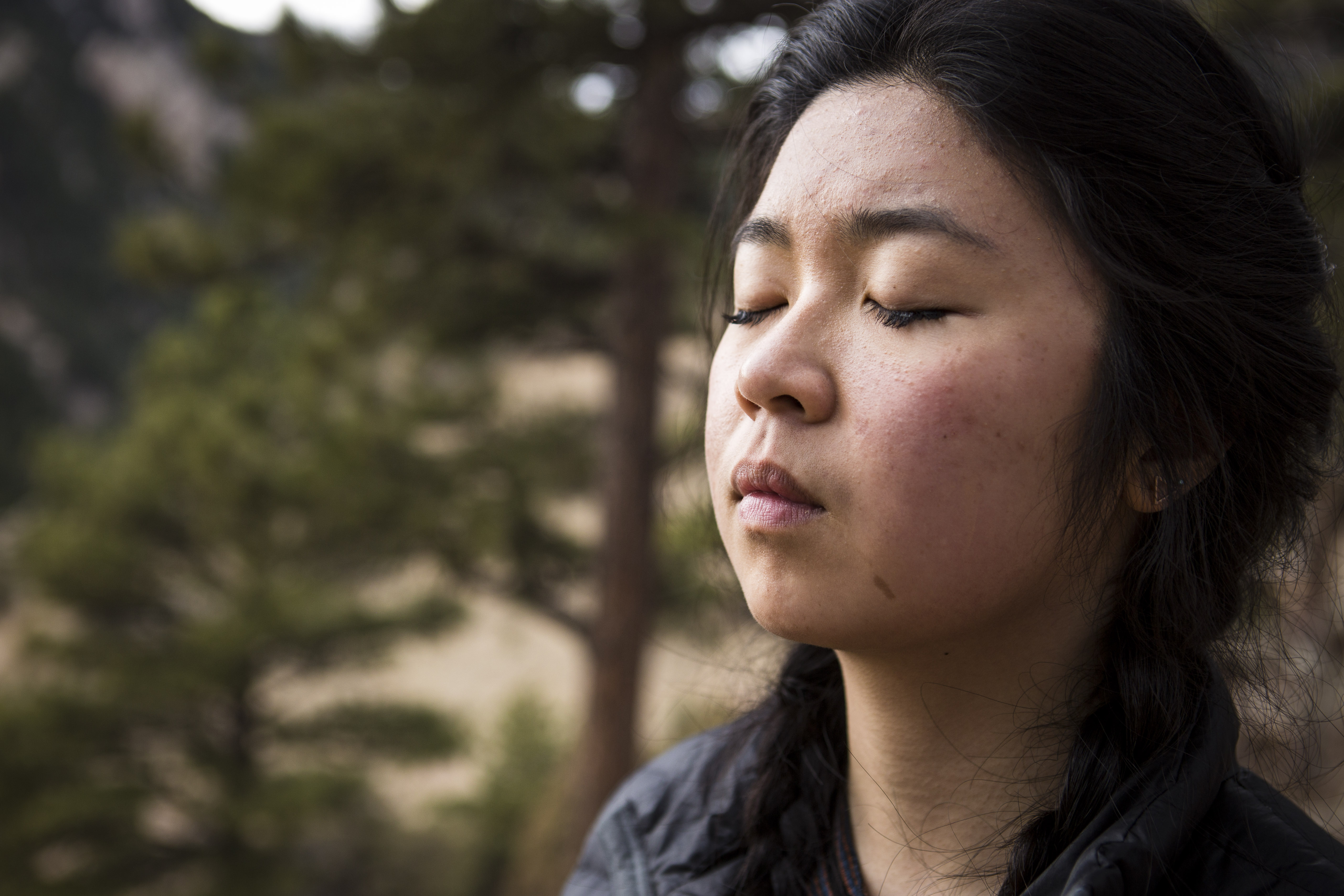
Amy Chen, 21, reflects on the day she almost died on Mount Harvard. She fell from Class Five terrain trying to cross the Harvard-Columbia ridge.
“I kept thinking to myself, maybe I’m late or maybe I’m early. I’m moving pretty slow so maybe people will catch up,” Chen said. “The parking lot was full at the trailhead. So I was like, someone else here has got to be climbing this thing.”
About a quarter of the way up the side of Mount Harvard, the snow under Chen’s feet turned to ice, and it became too steep to have second thoughts about her ascent. The only option was to keep pushing for the summit.
“That last 50 meters was like going up a sheer wall of ice, and I should’ve known better,” she said. “That’s where I took a deep breath and said to myself to be brave and get myself out of this.”
At around noon, Chen reached the summit after a nerve-jerking nine-hour hike. Joy overwhelmed her, but fight-or-flight kicked in when she realized getting down would be more of a challenge than coming up.
Without much time to waste, Chen formulated three options for her descent. The first, staying at the summit and waiting for death, was nonsensical. The other two options were to push for Mount Columbia, Harvard’s neighboring fourteener, either via the normal route that drops into the outside basin, or by crossing the Class 4 ridge connecting Harvard to Columbia’s summit.
Chen was well equipped, but only if she planned on making it back to the car the same day.
“I’m pretty geared up. I have a headlamp and all of my jackets. But I didn’t have enough to make the night, especially in that snow. There is no way you are starting a fire when everything is iced over,” she said.
For better or for worse, Chen decided to push for the summit of Columbia along the ridge. It seemed like the most logical option to get back to her car alive, but that wasn’t the reason she chose to take her chances scaling a ridge that’s just a few inches wide and coated with ice. Similar to her rationale for deciding to climb this mountain alone, Chen’s competitive spirit told her to push for the next summit—to bag another peak. She wanted to get 21 by 21, but she came up short.
“I thought I would be able to do it,” she said. “I saw someone else’s footprints take the ridge that I was on.”
About an hour after leaving the summit of Harvard, Chen slipped on the ice that coated the ridge and fell about 150 feet to the snow-covered rocks below. She doesn’t remember the fall or even the 15 minutes leading up to it.
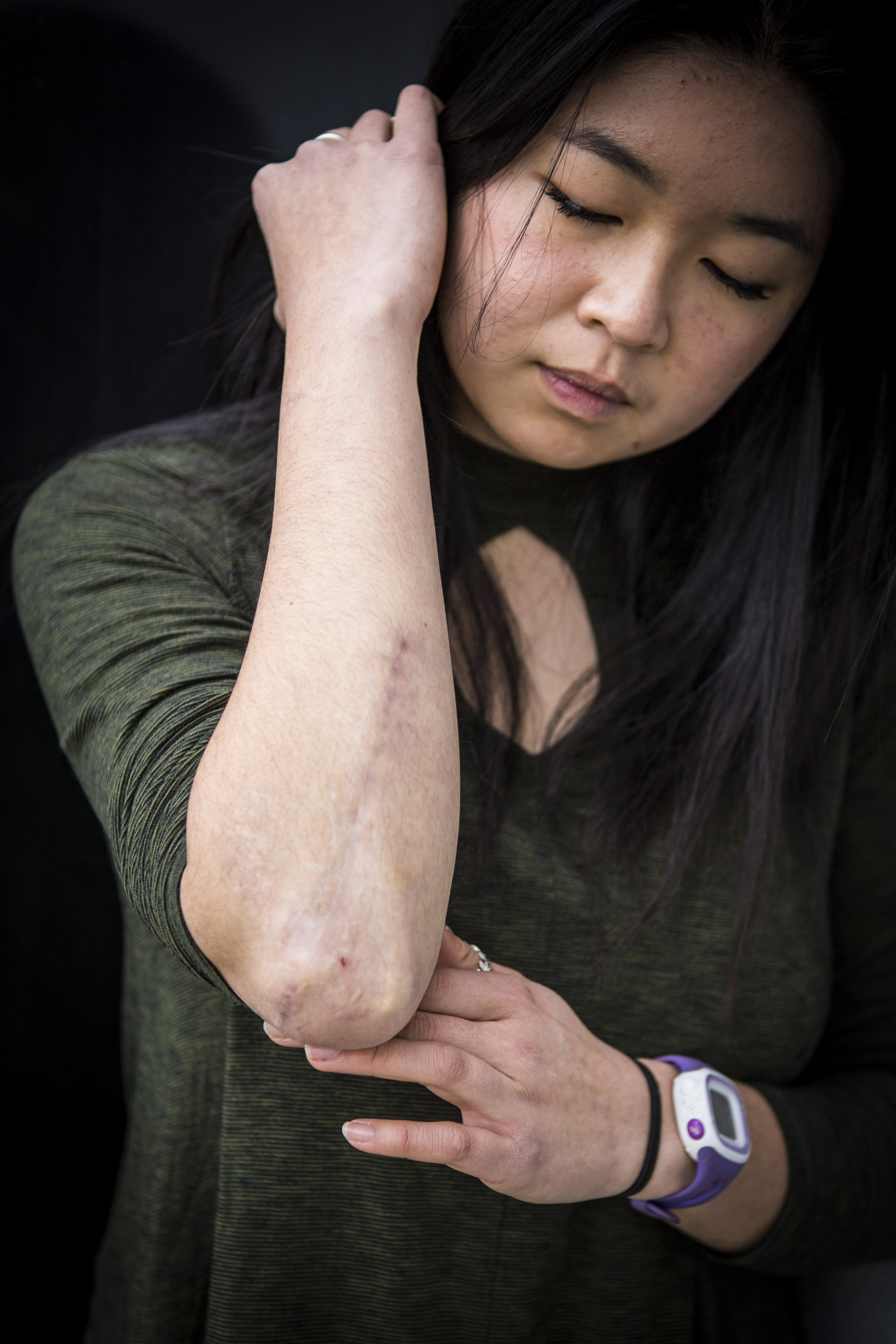
Chen looks at her scar seven months after surviving a 150-foot fall from Mount Harvard. Her olecranon (elbow) was shattered after her humerus was pushed through it.
For several hours, Chen remained unconscious. Wedged between two boulders, she didn’t move. The sleeve of the jacket covering her right arm was drenched in blood—her humerus was sticking out of her skin. Her legs bent at the knees and curled up behind her, making the spikes of her shoes dig into her back.
Life on the Line
A cell phone is something Chen usually leaves behind when packing for hiking trips. The weekend before she hiked Harvard, she got lost on another hike and used her friend’s phone to find her way back to the trail. After that scare, Chen thought twice about not taking a phone on her solo trip to Harvard.
Chen has what she calls a “burner” phone—a pre-paid flip phone that has “terrible service.” She knew it would serve no purpose in the back-country, so she took her family iPhone with her—a decision that saved her life.
All alone on the side of a 14,000-foot mountain, Chen woke from the nightmare she thought she was having. A few moments of confusion, and then the adrenaline kicked in. She panicked, but there’s no way she could get herself down that mountain in the condition she was in.
The iPhone was stored in the top pocket of her backpack, which was close enough for her to reach with the arm that wasn’t broken. She couldn’t move her legs because she shattered most of her lumbar spine — the upper and lower parts of her skeleton were totally disconnected. She couldn’t move her bloody arm, and the two chipped bones in her neck made it excruciating to turn her head. She thought she was paralyzed. Her survival depended on that cell phone.
“Amy, you’ve got to do this. Suck it up—it’s going to hurt. Open the pocket. Get the phone,” she said.
Two bars of service appeared on the phone’s screen when she finally got a hold of it. Three calls to 911 were dropped, but Chen remembered that texts messages get pushed through until they are delivered, unlike a phone call.
She typed into the family group chat, “Call 911 for me, fell off the Harvard Columbia ridge, can’t move” and crossed her fingers it would go through.
It was just after 6 p.m. when Chaffee County Search and Rescue (CCSAR) began communicating with Chen via text message after receiving a page about a solo hiker that had fallen off the Harvard-Columbia traverse. Two hours later, after finding their way past a locked gate and fallen trees along the road leading up to the Frenchman’s Creek trailhead, the CCSAR ground team began their search on foot.
Along with their effort on the ground, CCSAR was accompanied by a Flight for Life helicopter. When Chen saw them fly the first of four technical rescuers overhead, it was still light outside. By the time night had fallen, she had watched them fly back and forth multiple times.
Her eyes grew heavy. Her jaw ached in pain from the chattering of her teeth as she shivered to stay warm. Moments later, she built up the strength to send another message.
“Please come back. Are you going to leave me here, is this where I’m going to die? So cold, I don’t know if I can hang on much longer,” she wrote.
Search and rescue tried to mitigate the situation, but Chen was in the shadow of the ridge, making it nearly impossible to see her—even as she frantically waved her phone light in the air.
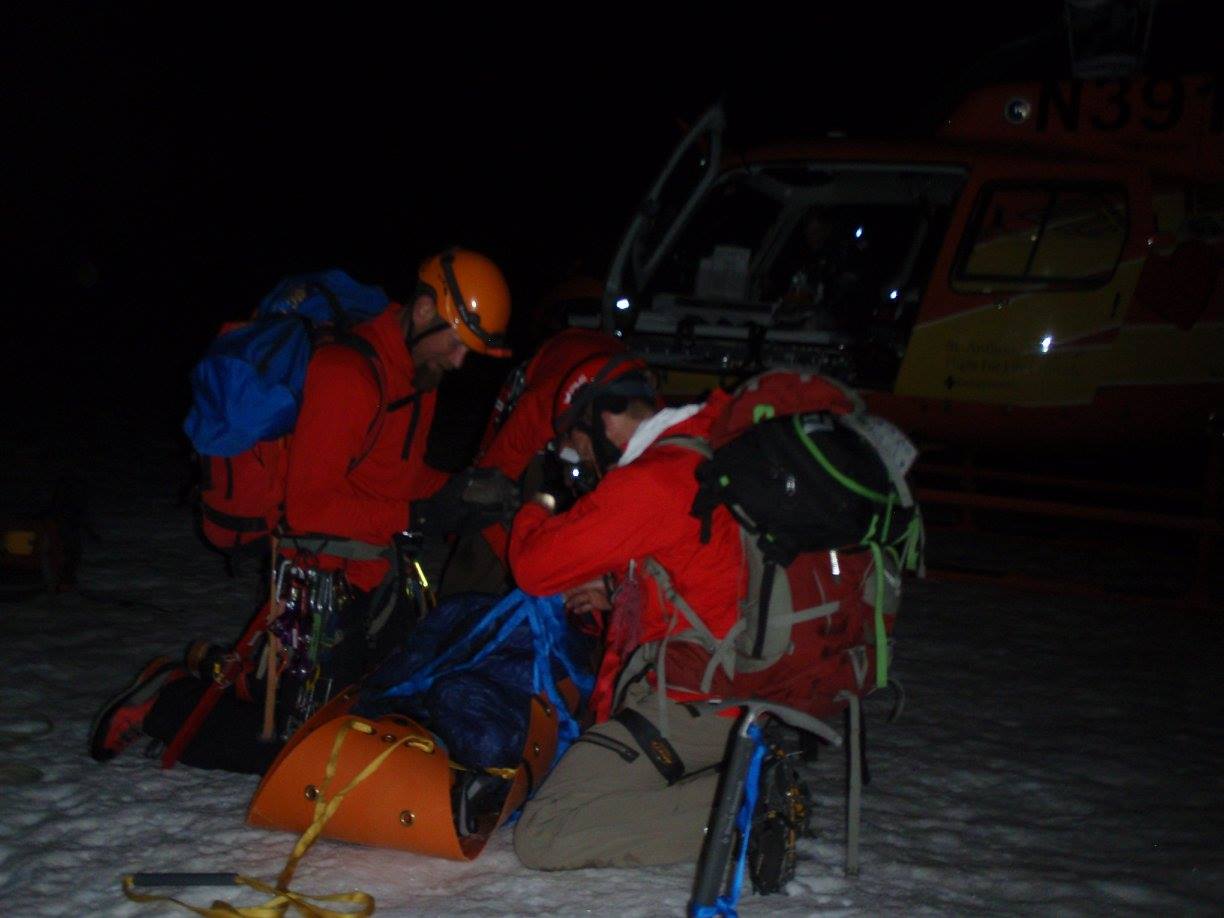
Chen being prepared for her flight for life. Photo courtesy of Chaffee County Search and Rescue North on Facebook.
According to Erik Rasmussen, a CCSAR volunteer who helped coordinate Chen’s rescue operation, she had fallen from the ridge proper, which is fifth class terrain.
“We had an idea of where she was based on the GPS data from her 911 call,” he said. “So she was essentially on fourth or fifth class—the side of the ridge basically.”
The rescuers in the sky were then inserted on the ridge, and they started making their way towards her in the middle of the night.
“So obviously it took a significant amount of time to get over to where she had fallen,” Rasmussen said. “Then that’s when we made voice contact, and then there was an actual technical descent down to where she was.”
It was 10:18 p.m. when rescuers made visual and audible contact with Chen. Dangerous terrain made it difficult for Flight for Life to land, and the technical descent rescuers faced delayed physical contact by another hour.
When rescuers found her, her body was numb, in part because of the pain from the injuries she sustained, but mostly because of how cold she was. It was 29 degrees, and she had been immobile for almost 12 hours.
“If I would’ve let myself fall asleep again, game over. I wouldn’t have woken back up,” she said.
At 2:07 a.m., Chen’s limp body was finally loaded onto the Flight for Life helicopter that flew her back to safety.
Lessons Learned
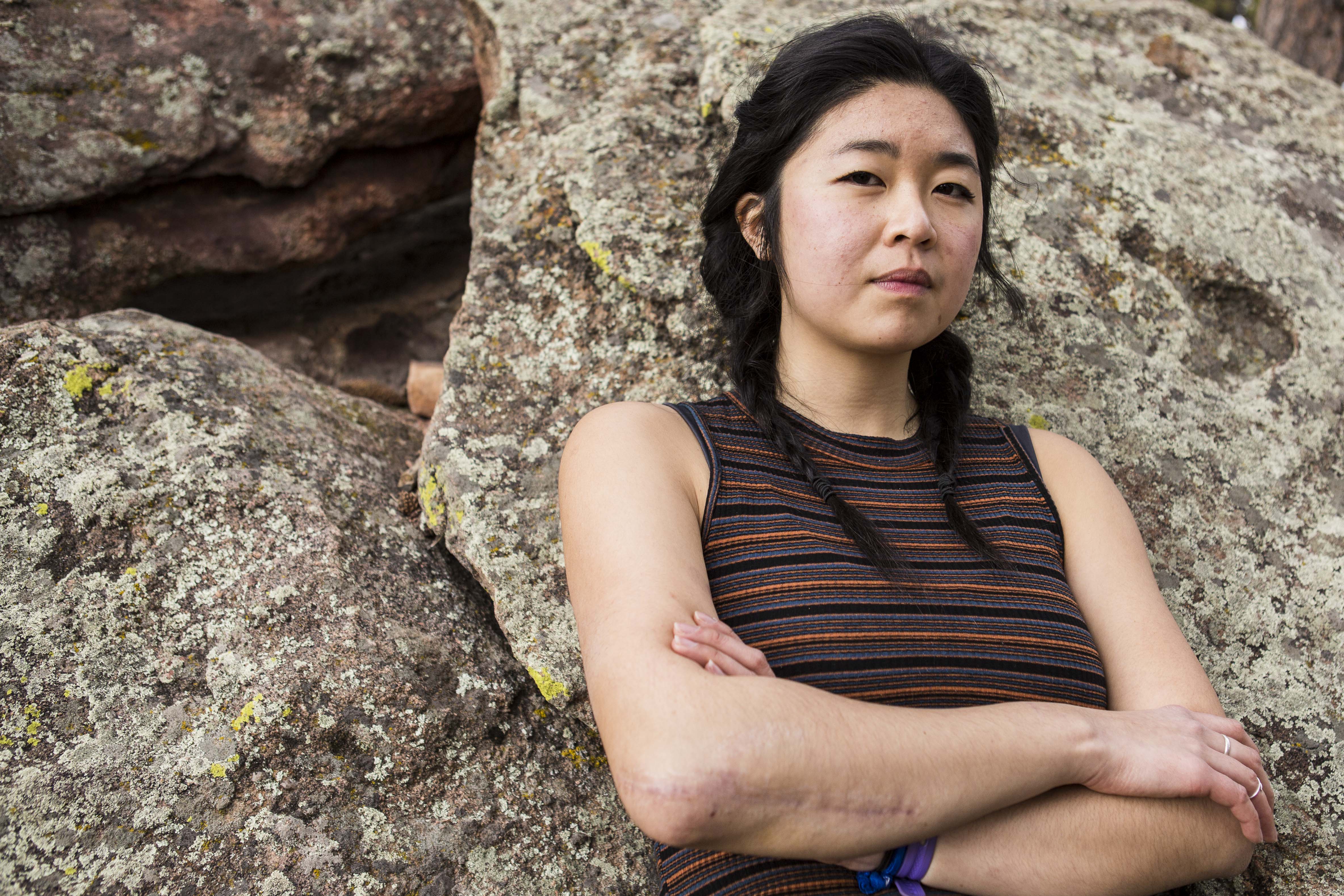
Amy Chen, 21, survived a fall last June that nearly left her dead. Just seven months later, she is back in the Rockies and determined to bag more 14ers.
Experiences like Chen’s can foster a new appreciation of life, but surprisingly, that didn’t happen to her. She never found a reason why she fell and survived, but she didn’t need to. She said that’s not how life works—things just happen, and they can happen at any time to anyone.
Recovering in her hospital bed, she felt guilty that volunteers spent so much time looking for her, risking their lives just to save hers. She had no way to repay them. Chen is motivated by this sense of guilt, and as she sat alone looking for a reason for why everything happened the way it did, she didn’t think she should be alive.
When it comes to school, things aren’t any easier for Chen, a senior at the University of Colorado. Doctors diagnosed her with a case of retrograde amnesia, which means she struggles to remember events that occurred, or information that was learned before she fell. She runs into people all the time whom she can’t remember, and she is having a difficult time in her final semester of college because her information recall is almost non-existent.
The woman that used to love rowing, jumping from ledges and climbing mountains is now more apprehensive about doing those same activities. She is the same independent, outdoor enthusiast she always was, but the brain damage she sustained from the fall has hindered her from embodying that lifestyle.
Although she struggles psychologically to be the same person she was before her 21st birthday, Chen is grateful to be alive.
“A lot of people did a lot of work to get me here for sure, and I’ve been healing remarkably quickly,” she said.
Her recovery in the hospital ended much sooner than doctors had estimated. Originally, she was told it would be six months before she would be able to walk again. Chen didn’t like the sound of that, and just two weeks after her surgery she was walking around on her own.
She moved into a studio apartment about a month after she was released from the hospital. Her injuries prevented her from doing simple things like opening jars of peanut butter or cutting carrots. She had to call friends for help.
And even though she wishes she could already be back to climbing mountains, the 21- year-old reminds herself that it’s miraculous that she still has the chance climb 21 fourteeners—just not by her 21st birthday.
“The fact that I’m getting around now is incredible, and I can’t really be mad about it,” she said. “I’m impatient, but I can’t be mad about it.”
All photography by Amanda Piela, unless otherwise noted.
